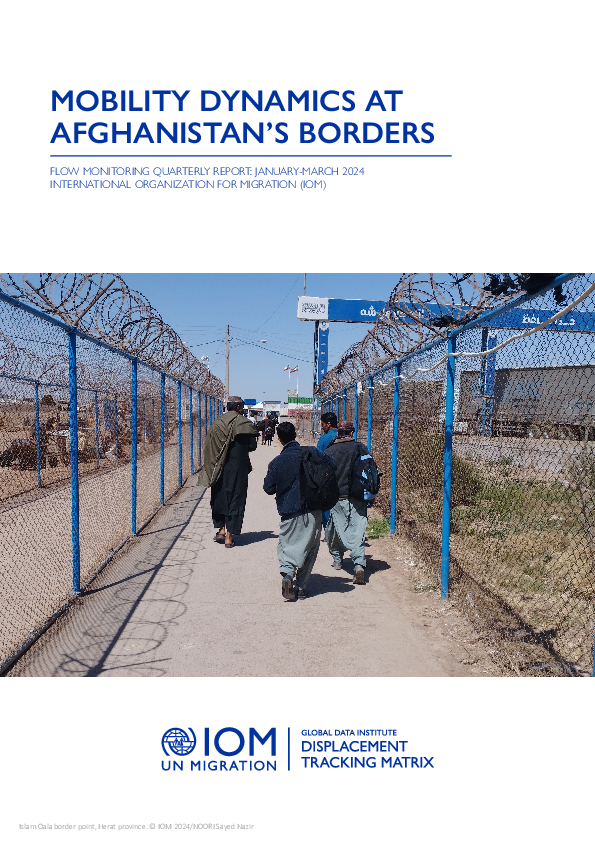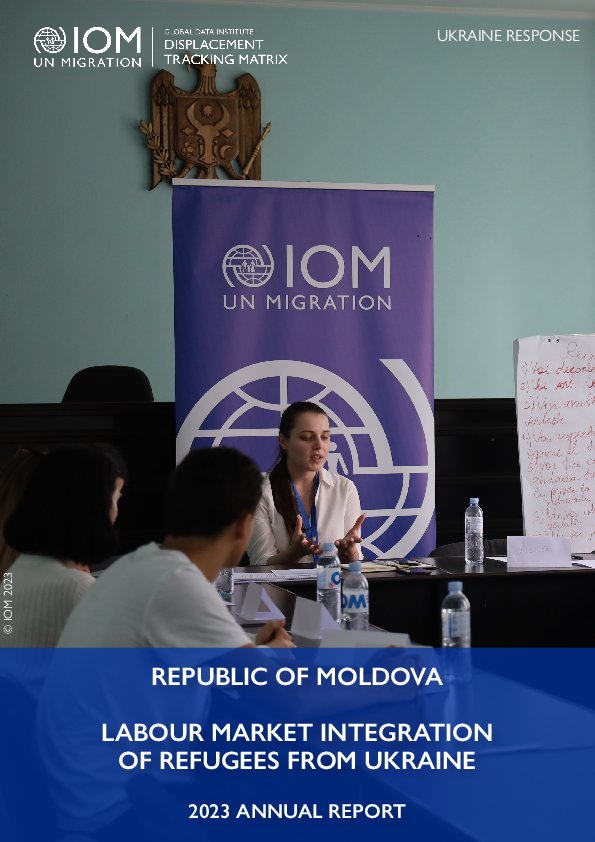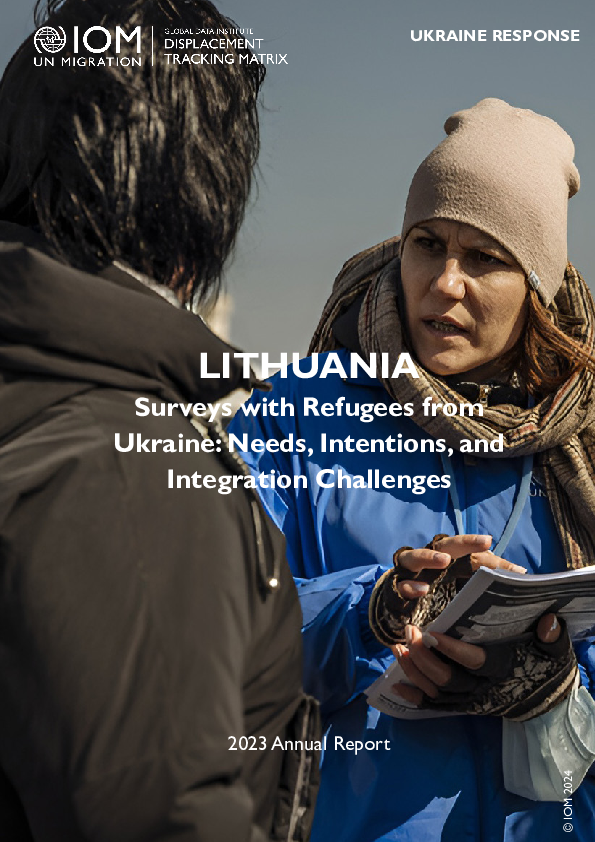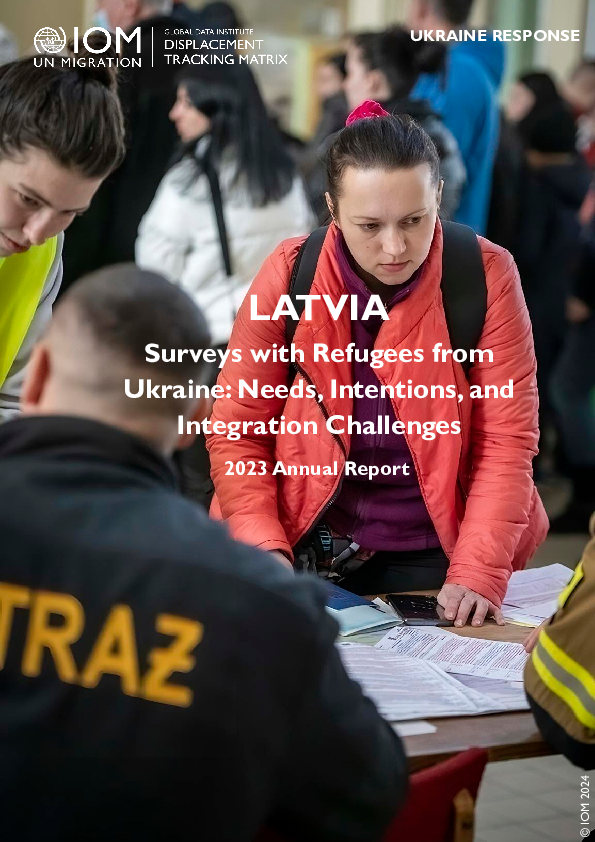-
Countries
-
Data and Analysis
-
Special Focus
-
Crisis Responses

Contact
DTMAfghanistan@iom.int
Language
English
Location
Afghanistan
Period Covered
Jan 10 2024
Mar 31 2024
Activity
- Survey
- Flow Monitoring Survey
- Flow Monitoring
Over the course of decades marked by conflict, Afghanistan has experienced significant movement across its borders with neighboring countries the Islamic Republic of Iran and Pakistan. This movement, influenced by linguistic, geographical, and economic factors, has played a crucial role in shaping regional dynamics and fostering cultural ties between these countries. With 4.5 million Afghan nationals currently living in the Islamic Republic of Iran and 3.2 million currently living in Pakistan1, Afghan nationals not only seek economic opportunities, international protection and safety in these countries, but often visit family or participate in short-term travel for health and other reasons. In late 2023, policies and statements by officials in both the Islamic Republic of Iran and Pakistan called for the expulsion of undocumented foreigners, the majority of whom are Afghan nationals. Developments such as these recent policies targeting Afghan migrants have impacted movements to Afghanistan, as seen late last year when returns from Pakistan increased following the announcement of the “Illegal Foreigners’ Repatriation Plan (IFRP),” setting a deadline for unregistered or undocumented foreigners to voluntarily return to their countries or face deportation.
In response to these recent movements, IOM Afghanistan re-launched its DTM Flow Monitoring (FM) activity at the beginning of 2024 to provide critical insights into current mobility dynamics at Afghanistan’s borders. Flow Monitoring is designed to track the scale and characteristics of human mobility along the borders, including volume, intended destinations, reasons for movement, and intended lengths of stay. From January to the end of March 2024, DTM counted 567,411 individuals entering Afghanistan, 406,919 leaving Afghanistan, and interviewed 49,441 regarding their reasons for movement and intentions. The following report provides findings from DTM’s Flow Monitoring exercises for the first three months of data collection, examining trends and profiles among inflow and outflow groups to inform better targeted response mechanisms.
The report is structured in four sections. The first section, “Cumulative Flow Trends,” gives an overview of the total inflow and outflow numbers and trends between January and March. This section is linked to DTM’s Flow Monitoring Counting exercise (see details in “Methodology and Limitations”). The second and third sections, “Mobility Dynamics: The Islamic Republic of Iran” and “Mobility Dynamics: Pakistan” explore findings from interviews with people leaving and entering Afghanistan via borders with the Islamic Republic of Iran and with Pakistan, respectively. These sections are followed by “Mobility Dynamics: Conclusions” which summarizes and analyzes the findings from the interviews. These last three sections are linked to DTM’s Flow Monitoring Surveys exercise (see details in “Methodology and Limitations”).

Contact
DTM Europe, DTMMediterranean@iom.int
Language
English
Location
Republic of Moldova
Period Covered
Jan 01 2023
Dec 31 2023
Activity
- Survey
Key Findings:
- Among respondents, 41 per cent are active (employed or unemployed), and 53 per cent are inactive (student status, parental leave, retirement, unemployment and not looking for a job).
- Within active population, 64 per cent are employed and 36 per cent are unemployed.
- Before displacement, 81 per cent were employed and 19 per cent were unemployed.
- Top 4 sectors of employment includes: accommodation (13%), wholesale and retail (11%), education and science (10%) and human health and social work (9%)
- Satisfaction with job and skills matching is higher among men (74%) than women (71%)

Contact
DTM Europe, DTMMediterranean@iom.int
Language
English
Location
Lithuania
Period Covered
Jan 01 2023
Dec 31 2023
Activity
- Survey
- Flow Monitoring
This report is based on a survey of displacement patterns, needs and intentions conducted by IOM’s Displacement Tracking Matrix (DTM) in the 11 countries included in the Regional Response Plan for Ukraine in 2023: 6 countries neighboring Ukraine – Belarus, Hungary, Poland, Republic of Moldova, Romania and Slovakia – and other 5 countries particularly impacted by the arrivals of refugees from Ukraine since the start of the war in February 2022 – Bulgaria, Czechia, Estonia, Latvia and Lithuania.
The analysis provided in this report is based on annual data collected from March to November 2023

Contact
DTM Europe, DTMMediterranean@iom.int
Language
English
Location
Latvia
Period Covered
Jan 01 2023
Dec 31 2023
Activity
- Survey
- Flow Monitoring
This report is based on a survey of displacement patterns, needs and intentions conducted by IOM’s Displacement Tracking Matrix (DTM) in the 11 countries included in the Regional Response Plan for Ukraine in 2023: 6 countries neighboring Ukraine – Belarus, Hungary, Poland, Republic of Moldova, Romania and Slovakia – and other 5 countries particularly impacted by the arrivals of refugees from Ukraine since the start of the war in February 2022 – Bulgaria, Czechia, Estonia, Latvia and Lithuania.
The analysis provided in this report is based on annual data collected from January to December 2023.

Contact
DTM Europe, DTMMediterranean@iom.int
Language
English
Location
Latvia
Period Covered
Jan 01 2023
Dec 31 2023
Activity
- Survey
From January to December 2023, Displacement Tracking Matrix (DTM) gathered information on the Needs, Intentions, and Integration Challenges faced by Ukrainian refugees in Latvia, conducting interviews with a total of 1,155 individuals throughout the year. This report explores the employment profiles and prospects of the adult respondents, with a special focus on those who have either expressed an intention to stay or have already established themselves in the country (N=171). These individuals, referred to as ‘stayers’ in this study, are actively investing their human and social resources to fully integrate into the host community. The report further narrows its analysis to a subset of 155 respondents who are within the working age bracket (18-64 years old), offering insights into their involvement in the labour market and detailing their experiences, needs, and intentions concerning employment in Latvia for the duration of their displacement.

Contact
dtmukraine@iom.int
Language
English
Location
Ukraine
Snapshot Date
Mar 01 2024
Activity
- Survey
Revisions to the eligibility criteria that came into effect in March 2024 limited access to the IDP living allowance based upon a specific set of socio-economic vulnerability profiles. This introduction of additional criteria is intended to ensure that social assistance in Ukraine is capable of supporting the most vulnerable, both among those who have been displaced and the general population. However, this increases the risk of excluding some vulnerable individuals who may lose access to the IDP living allowance under the new criteria. This reduction in monthly household income could impact on the ability of vulnerable households to meet their basic needs and rebuild their lives.
The purpose of this brief is to provide an overview of the estimated share and number of IDPs that may still be eligible for the IDP allowance under the new policy. Using available secondary data, this thematic brief aims to provide an indicative overview of the share and number of IDPs that will not be eligible anymore, despite being vulnerable to a reduction in household income that could affect their ability to meet basic needs. The brief intends to inform and support advocacy and programming of humanitarian partners in complementarity with the new IDP allowance scheme.

Contact
DTMUkraine@iom.int
Language
English
Location
Ukraine
Period Covered
Mar 01 2024
Mar 31 2024
Activity
- Baseline Assessment
The Registered IDP Area Baseline Assessment provides granular data on the number and geographic location of officially registered internally displaced people (IDPs). This report assesses registered IDP presence at the hromada level, also mapping the recorded change since the previous round.
The data collected for the Area Baseline Assessment Round 34 reflects the up-to-date local administrative register of the IDP population as of 31 March 2024, equivalent to a total of 3,387,291 registered IDPs. Registered IDP figures were collected for 1,098 hromadas (83% of all hromadas covered in Ukrainian government-controlled areas), across 108 raions and 23 oblasts. Data disaggregated by age, sex and disability status were provided for around 83 per cent of the administrative units covered.

Contact
DTM Sudan; dtmsudan@iom.int
Language
English
Location
Sudan
Period Covered
Apr 15 2023
Apr 04 2024
Activity
- Mobility Tracking
- Baseline Assessment
To mark one year since the outbreak of conflict in Sudan, this report analyses the evolution of displacement based on DTM data collected throughout the past year of conflict.
An interactive Story Map presenting more granular data is available here.
Key Findings:
- An estimated 6,657,550 individuals were displaced internally within Sudan since the start of the conflict one year ago, on 15 April 2023.
- Approximately 2,044,248 individuals were reportedly displaced across borders into neighbouring countries.
- An estimated 13 per cent of the population in Sudan was displaced during the past year of conflict.
- Over half (approximately 53%) of individuals internally displaced were children, under the age of 18 years old. Approximately 22 per cent were children under the age of 5 years old.
- Approximately 10 per cent of localities across Sudan experienced a population increase of 50 per cent or higher due to the influx of displaced individuals, exacerbating pressure on already-limited resources and services.
- Sudan hosted approximately 13 per cent of all internally displaced persons globally, and nearly 1 in every 8 internally displaced persons worldwide is Sudanese.
- Approximately 28 per cent of displaced individuals were female children under the age of 18, who faced unique protection risks.

Contact
DTM Uganda, dtmuganda@iom.int
Language
English
Location
Uganda
Period Covered
Mar 01 2024
Mar 31 2024
Activity
- Mobility Tracking
- In March there were reports of affected people due to Heavy Storms or Hailstorms in the districts of Kanungu (8,620), Namisindwa (825), Bunyangabu (580), Buikwe (262), Mubende (40) and Wakiso (25). In Kampala (24) and Bundibugyo (5) were reports of affected people due to fires, while in Buikwe nine people were affected by a transport-related accident.
- The impacts of the hazards affected 10,390 individuals (2,387 households), with 426 people from 91 households were internally displaced. Children below the age of 18 were the most affected age group (67%), followed by adults (18-64) at 30% and elderly above 64 (3%). Notably, more than half of affected people were female (62%).
- Urgent needs identified include sanitation, nonfood items, food assistance among others. Infrastructure damage assessed indicated that 213 houses were partially damaged, 41 houses were completely destroyed, 5 schools, 1 water facility and 1 health facility were affected.

Contact
DTM Haiti, dtmhaiti@iom.int
Language
French
Location
Haiti
Period Covered
Mar 08 2024
Apr 09 2024
Activity
- Survey
- Flow Monitoring Survey
- Flow Monitoring
Since end of February 2024, the security situation has deteriorated in the Metropolitan Area of Port-Au-Prince (MAPAP), the capital of Haiti. In addition to creating displacement within the MAPAP, generalized insecurity are pushing more and more people to leave the capital to find refuge in provinces, taking the risks of passing through gangs-controlled routes. In order to monitor these movements towards provinces and inform appropriate response strategies, DTM has launched data collection at several of the most used bus stations in the capital (see page 5 for more details on the methodology). In one month of implementation of this activity (since 8 March), movements of 94,821 people leaving the MAPAP have been observed (see pages 3 and 4 for more details on their profile). The majority of them (58%) took means of transport heading towards the Grand Sud departments (Grande’Anse, South, Nippes and South-East). It should be noted that this region already hosts more than 116,000 people who had in vast majority, fled the MAPAP in recent months (see the report on displacement in the Grand Sud). Half of flows headed towards 3 main destination municipalities: Jérémie (in Grande’Anse), Les Cayes (South) and Léogâne (West).
It should be emphasized that provinces do not have sufficient infrastructures and host communities do not have sufficient resources that can enable them to cope with these massive displacement flows coming from the capital.
It should be noted that at the beginning of March, when the security situation worsened, people who were already internally displaced (IDPs) were the first to begin leaving the capital. Over time, more and more people who were not IDPs are also leaving: as of 10 March, 86% of people leaving the MAPAP were IDPs. One month later, this percentage dropped to 60%, while almost 40% were those who had never fled their residence and who decide to leave it and seek refuge in provinces. This further describes the deterioration of the situation in the capital, given that leaving the capital could be a relatively quicker decision to make for a person who was already displaced than for someone who was still in their residence and decides to leave it for seek refuge in provinces.